Norma Precision, a Swedish manufacturer of brass, powder, bullets, and
loaded ammo is 101 years old this year. While itís always had a reputation for
high quality, the availability of its products in the United States has been an
on and off thing over the years. Lately things seem to have stabilized, and now
these products are available from several sources.
The Swedish firm was actually founded by a couple of Norwegians - the Enger brothers. Consequently, a lot of people assume that the name "Norma" has
something to do with Norway. Not so. It turns out one of the brothers was an
opera buff, and a popular work of the time was the opera "Norma" by the Italian
composer Bellini. Iím just glad Mr. Enger wasnít into German opera or the
companyís name might have been "Bromhilda" or something similar. Now thereís a
name that would catch your attention when shopping for components!
At any rate, Iíve always been curious about Norma reloading powders
but never had an opportunity to try them out. However recently, I was able to
obtain a pound of Norma 201 to play with. Itís sold in the old style rectangular
metal cans and is sealed with a sturdy aluminum cap under the twist off top.
This is not your typical thin foil seal, so removing it requires you to pierce
it with something like a screw driver or similar tool and then pry it off.
|
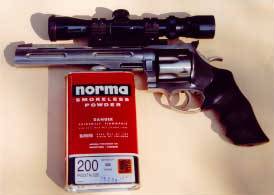
|
|
"Another powder in the line up, Norma 200, is somewhat slower
than 1680 and is useful for large capacity pistol cartridges" |
|
The powder itself is a relatively short cut extruded type and is
fairly easy to meter. However like with any "stick" powder you will get an
occasional hang up in your powder measure.
In searching around, I found absolutely no reloading data for
silhouette type cartridges. Consequently, I decided to take a fairly cautious
route in trying to develop a load for my XP 7BR. The first stop was to go to the
powder burn rate chart in Sierraís new reloading manual. My goal was to see how
201 compared to other popular powders used in the 7BR such as AAís 2015 and
Hodgdonís H322. The chart listed the powders in this order from fastest to the slowest:
|
AA2015 |
|
Reloader 7 |
|
IMR 3031 |
|
Benchmark |
|
Norma 201 |
|
H322 |
We all know that the burning rate of any powder can vary somewhat from
one production run to another. In other words, you could then have powder from
one lot which was at the fast end of its burn rate specification being compared
to a run of another powder that was at the slow end of its specification. The
differences between the two powders could then be exaggerated. Consequently, we
have to take these burn rate rankings with a grain of salt. However the chart
did indicate that those six powders were in the same general class.
Since I had a good supply of both H322 and AA2015 on hand I decided to
do a limited side by side comparison with Norma 201. Still not knowing exactly
how the Norma would perform in a 7 BR, I decided to use a modest load of 26
grains with a 140 grain Remington bulk bullet, ignited by the ever reliable
Winchester small rifle primers.
The first step was to set up my Redding BR powder measure to throw 26
grains of Norma and assemble ten cartridges. I then replaced the 201 in the
measure with Accurateís 2015. According to my RCBS electronic scale, the same
powder measure setting now threw 26.1 grains of 2015. So the 201 and the 2015
powders had, for all practical purposes, the same volume to weight ratio. I then
adjusted the measure to throw exactly 26 grains of 2015 and then assembled
another 10 cartridges.
|
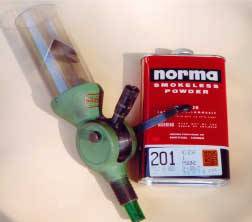
|
|
"Norma 201's volume to weight
ratio was almost identical to AA2015" |
|
I then went back to the original Norma setting and replaced the powder
in the measure with H322. The Redding then threw 26.8 grains, indicating that
there was a greater difference in the volume to weight ratio. As before, I then
adjusted the measure to throw 26 grains of H322 exactly and assembled 10 more
cartridges.
|
26 grains Norma 201 = 26.1 gr. AA2015 |
|
26 grains Norma 201 = 26.8 gr. H322 |
Now it was time to go to the range. In shooting
the three loads across my Oehler chronograph, I didnít notice any real
difference in recoil or muzzle blast. My XP is equipped with a Mike Dewey
muzzle brake which moves the gun straight back instead of swinging the
muzzle upwards. Recoil wasnít objectionable in any way. Here are the
|
Powder |
Velocity |
SD |
|
Norma 201 |
1880 |
11 |
|
Hodgdon H322 |
1959 |
12 |
|
Accurate 2015 |
2010 |
25 |
numbers taken at 10 feet.
The differences in velocity aren't enormous but they are significant.
Remember, velocity and pressures go hand in hand and so it would appear that the
Norma powder would be an easier load on gun and brass - all other things being
equal.
I then worked up some rough sight settings, and at the next match at
the Redlands Fish and Game range shot a 40 with this same load. So the bottom
line here is that Norma is indeed a high quality product and is a viable
alternative choice for silhouette cartridges. However, when working with any
powder for which reloading data is unavailable, take a cautious, very
conservative approach. A Norma reloading manual is supposed to be available
about the time this is published. Whether it will contain any data for
silhouette compatible cartridges is unknown. Some limited reloading data is
available at the Norma web site. Norma components can be purchased at Graff &
Sons (www.grafs.com), Widners Reloading (423-282-6786), Midway (800-243-3220),
NECO (707-747-0897), Sinclair International (219-493-2530), Black Hills Shooters
Supply (605-348-4477) and Huntington (530-534-1210). Try a can.
Lewis Lead Remover - Brownellís has got to be the absolute largest source of gunsmithing
and general shooting supplies in the world. At last count, it stocked something
like 29,000 separate items. Well, now itís up to 29,001 with their recent
purchase of the Lewis Lead Remover.
This tool has been around since 1954 and is definitely one of the most
effective ways of getting rid of really heavy bore leading. You know the kind -
where lead is smeared from one end of the barrel to the other. You might try
chemical cleaners to clean all that stuff out, but I guarantee that big of a job
has the potential to be an all day affair. When really heavy leading is present,
mechanical removal is best. Thatís where the Lewis Lead Remover comes in.
The Remover consists of a short rod with a handle at one end, an
aluminum cone tip, and a small hard rubber cylinder over which a brass mesh
patch is fitted. The rubber cylinder with patch is then screwed on to the end of
the rod. The idea is to pull the tight fitting cylinder and mesh patch through
the bore, and thus scrape off the adhering lead. Donít worry about the brass
mesh patch scratching the bore. Brass is much softer than steel and so there is
no way that the bore is going to be harmed. To clean up any remaining light
residue, you can then follow up with JB Bore Cleaner (also from Brownells) or a
good conventional bore cleaner like Iossoís or Shooters Choice to make sure any
remaining bits of lead are totally removed.
A friend of mine has owned a couple of Lewis Lead Removers for over 20
years and I can tell you that they do indeed work. If youíre a cast bullet
shooter, one thing that you have to be careful about is lead build-up, not in
the bore so much, but rather on the forcing cone of revolvers or in the throat
of your single shot pistols. Over time, this can occur even with the best of
alloys.
Fortunately you can do a visual check of revolver forcing cones fairly
easily, although most people donít, but should. However, unless you own a bore
scope, determining whether lead has built up in the throat of your single shot
pistol, or in your rifle, can be difficult to impossible. Believe me, any lead
build-up in those areas will degrade accuracy, often dramatically.
My first silhouette revolver (bought used) wouldnít shoot worth beans
no matter what I did or what load I used. It drove me nuts for a couple of
months and I was ready to give up and sell the darned thing or throw it in the
Gulf of Mexico. Then on a whim, I did a close examination of the forcing cone
with a magnifying glass. I found all kinds of uneven lead build-up around the
diameter of the cone. I found out later that the previous owner was shooting a
lot of soft cast bullets for a plinking load. I quickly realized that the lumpy
lead residue was tearing up my own cast bullets as they were entering the bore.
It was even affecting accuracy with my jacketed bullets. I then borrowed a Lewis
Lead Remover from my friend.
To clean up forcing cones, the cone shaped aluminum tip is used.
Simply pass the rod through the bore to the forcing cone end and screw on the
aluminum tip with brass patch. Next pull back on the gun to put some pressure on
the tip/patch combo and rotate the rod or gun (which ever is easier) four or
five turns. This should do the job. After I had followed the procedure, the gun
immediately started shooting much better groups.
|
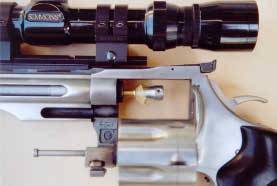
|
|
" Lead buildup on a forcing cone is easily overlooked" |
|
In a more recent example of the effects of lead build up, a friend of
mine bought a beautiful Winchester Model 52 target rifle made at least 50 years
ago that was in pristine condition, including the bore. However, it really
wouldnít shoot very well. I did a bore scope examination and found lead deposits
had built up in the throat over those many years. With an appropriately sized
tip, the Lewis Lead Remover could have instantly solved that problem. The point
Iím making here is that you can have a bore thatís totally lead free, but still
have a lead problem that will ruin the accuracy of a perfectly good gun.
The Remover comes with a small supply
of brass mesh patches in the appropriate size. Thereíre very durable and last
quite a while. If they get gummed up with oil, lead, powder residue, etc., you
can use Shooterís Choice Scrub Out spray or a similar product to clean them up
to be used again. Itís really hard to wear one out.
|
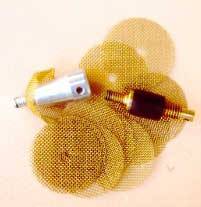
|
|
"Brass patches will effectively scrub out even heavily leaded
bores" |
|
One limitation of the Remover kit is that the
handle supplied canít accommodate barrels that are over 8" long, which of
course is a problem with silhouette revolvers and single shots which
typically have longer barrels. Not to worry, the rubber tip to which the
copper patch is attached for bore cleaning can be screwed on to a standard
cleaning rod and thus be used on any length barrel. The factory supplied
handle is just right however for cleaning lead out of cylinder throats. As
an alternative to a kit, you could just to order the tips and patches
without the handle.
|
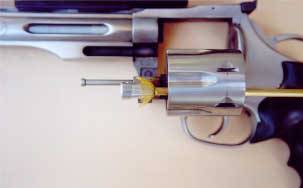 |
|
"Lead buildup in the cylinder can ruin the best
of loads" |
|
Another limitation of the Remover is that it is made just for pistol
and revolver calibers ie. 9mm, 357, 41, 44, and 45. Remover tips in rifle
calibers would be just as useful, if not more so, considering the popularity of
lead bullets for pistol silhouette and rifles, but aren't available. In fact, a
kit of just cone tips and patches that would include popular pistol and rifle
calibers that could be attached to a regular cleaning rod would cover all the
bases. Now that Brownells has taken charge of this product, I hope theyíll
consider offering such a product.
So if you shoot cast
bullets in a revolver or in a single shot chambered in a revolver cartridge, and
your groups aren't what they used to be, you may have a lead build-up problem
somewhere that needs attention from a Lewis Lead Remover. Visit Brownells at
It has one of the best, and most concise dissertations of exterior
ballistics you can find any where.
Hereís a synopsis of what it said. When shooting into the wind, the
relative speed of the air moving over the bullet is greater than it would be if
the wind was calm. For instance, if the bullet is going 2000 fps out of the
muzzle and the wind is blowing 50 fps, the relative speed of the air over the
bullet is now 2050 fps. Itís still going 2000 fps over the ground,
but the air moving over it is going 2050 fps.
|
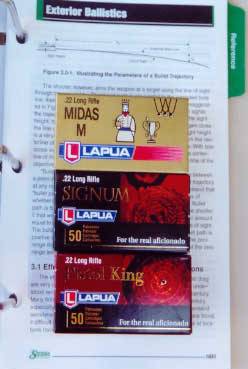
|
|
"The Sierra manual
has the best discussion of exterior ballistics available" |
|
This increased air velocity creates additional drag on the bullet,
especially at its base where there is a lot of turbulence going on. The end
result is the fact that a headwind will create and maintain a higher rate of
drag than would occur in calm air, and that will slow the bullet more than it
would have been otherwise. As a result, it will drop further.
The opposite is true in a tail wind. With the wind blowing behind the
bullet, less drag is occurring and the bullet will hit higher than it would in a
head wind.
This now begs the question of just exactly how much
a bullet will drop, or not drop, in a head or tail wind. A good ballistic
program such as is available from Sierra or Speer will tell the story. I asked
my good friend Dr. Jim Williams to crunch the numbers for me using the Sierra
Infinity ballistics program. I assumed we were using a match type 22 rimfire bullet going 1080 fps. The bullet would be dealing with either a 10 mph head
wind or a 10 mph tail wind. The program was asked to calculate the effect at 100
yards. Hereís the results.
|
Bullet Drop at 100 Yards Calm Wind - 4.07" |
|
Bullet Drop
at 100 Yards 10 mph Head Wind - 4.20" |
|
Bullet Drop
at 100 Yards 10 mph Tail Wind - 3.95" |
So you can see that the greatest amount of bullet drop is occurring
when the bullet is facing the wind. However in the case of our 22 at 100 yards,
the amount of bullet drop is so insignificant (.13"), itís totally meaningless.
In practical terms then, it doesnít amount to a hill of beans. So when shooting
a 22 and the wind is blowing straight at you or away from you, donít let it
psych you out. Just use your regular sight settings and hold, and slap the
steel.
Buyer Beware or Why Wonít It Shoot
- Thereís always a certain element of risk when buying a used gun,
especially if itís from someone you donít know. That fact was reiterated when I
got a telephone call a some time ago from a silhouette shooter. Seems he just
bought a used XP at a gun show chambered in .308. Our shooter thought he could
use it for hunting and silhouette matches as well. The problem was that he
couldnít get the gun to shoot. Even though he had a Leupold 2 X 8 scope on the
XP, the best it would do at 100 yards was 12-14 inches. Now thatís what I call
ugly.
When a gun is shooting that badly, itís usually indicative of a
problem with the scope or the rings, or maybe the scope mount itself. I first
suggested that he check to see that everything was tight. Nope, he reported no
problem there. I then suggested he remove the bolt and shake the gun to see if
he heard any rattling sounds from the scope. This would indicate loose or broken
parts inside the scope. No problem.
Ok. Although it wasnít very likely that there was a problem with the
scope, I suggested he put another scope on the gun to see if it made any
difference. Sometimes, in spite of the odds, even a good scope can go bad. A
couple of days later, the shooter called back to say he had switched scopes and
the results were the same as before.
I then thought, "Well, maybe this guy just canít shoot with a scope."
I then suggested that he ask someone who he know to be a good shooter to try the
gun off the bench. The following Sunday night he called again to say that a
friend tried the gun and that he got similar results.
We then talked quite a bit about his loads and his reloading technique
and equipment. Everything seemed normal.
That left the gun as the problem. To be honest, thereís not a lot of
things that can go wrong with an XP. He reported that the gun was in good
condition and that the fired brass looked ok. In fact the gun had even been
recently re-barreled. I then asked him to remove the bolt and look down the
barrel while the muzzle was pointing at a white piece of paper with a strong
light on it. This technique will throw a lot of light into the barrel making it
fairly easy to examine the bore. I then asked him to look where the lands ended
just in front of the chamber. Were the ends of the lands crisp, or were they
smooth and tapered (indicating a shot out barrel). He reported that the lands
were nice and crisp. No wear.
I then asked if he saw any pitting or tool marks on the lands. No
problem. Everything was clean.
I then asked him to look at the crown. Were there any burrs, nicks, or
other damage? No. Was the crown cut square. Yes. I then suggested that if he had
a magnifying glass he look at the lands at the muzzle. Any damage? No. At this
point I was ready to tear my hair, and it wasnít even my gun.
Finally, on a desperate hunch, I asked our shooter to get a cleaning
rod and put on a very tight fitting patch and to slowly push it through the
bore. The idea here was to see if there were any restrictions or loose spots in
the barrel. Sure enough, about three quarters of the way down, our frustrated
shooter found a loose spot. It was a big one too, about an inch and a half long.
He said it was like "Falling into a big hole". The bad news wasnít over yet.
About an inch in front of the loose spot, he found another about a half inch
long.
Needless to say we were happy we found the problem but we both knew
that the barrel would never shoot and that it would have to be replaced even
though it was brand new. A couple of weeks later, our shooter called again to
say he took the gun back to the individual he bought it from. After asking a lot
of very hard hitting questions, he found out the XPís new barrel had been made
from an overseas army surplus machine gun barrel. Enough said on that! Last I
heard, our friend was still trying to get some satisfaction from the seller.
To summarize, when experiencing a mysterious lack of accuracy, follow
these eight steps.
-
1. Check the scope rings & mounts for
tightness.
-
2. Check the scope for gross internal damage
by shaking.
-
3. Switch the scope with another and shoot a
group.
-
4. Ask a shooter of known ability to shoot a
group with your gun.
-
5. Use only a well proven load assembled with
quality reloading tools.
-
6. Examine the lands in front of the chamber
for wear or lead build up.
-
7. Examine the muzzle for damage or incorrect
crowning.
-
8. Push a tight patch through the bore
checking for loose spots or restrictions.
The bottom line here is when buying a used gun from someone you donít know,
check the things we talked about here and youíll have a better chance of getting
a genuine bargain instead of a headache.
![]()